
Mädler is a crater on Mars. It was named in honor of the German astronomer Johann Heinrich Mädler by the IAU in 1973.
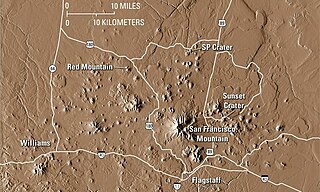
The San Francisco volcanic field is an area of volcanoes in northern Arizona, north of Flagstaff, US. The field covers 1,800 square miles (4,700 km²) of the southern boundary of the Colorado Plateau. The field contains 600 volcanoes ranging in age from nearly 6 million years old to less than 1,000 years, of which Sunset Crater is the youngest. The highest peak in the field is Humphreys Peak, at Flagstaff's northern perimeter: the peak is Arizona's highest at 12,633 feet and is a part of the San Francisco Peaks, an active stratovolcano complex.

Holden is a 140 km wide crater situated within the Margaritifer Sinus quadrangle (MC-19) region of the planet Mars, located with the southern highlands. It is named after American astronomer Edward Singleton Holden. It is part of the Uzboi-Landon-Morava (ULM) system.
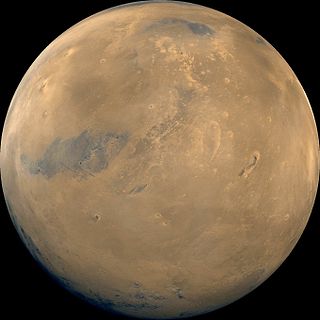
Cerberus is a large "dark spot" located on Mars and named after the mythical dog Cerberus. The arcuate (curved) markings in the upper right are in the Amazonis plains and may be sand drifts. The volcano Elysium Mons, a yellow area north of Cerberus, has several channels radiating from its flanks. The three bright spots, upper left, are volcanoes partially veiled by thin clouds.

Newton is a large crater on Mars, with a diameter close to 300 km. It is located south of the planet's equator in the heavily cratered highlands of Terra Sirenum in the Phaethontis quadrangle. The crater was named in 1973 by the International Astronomical Union (IAU) Working Group for Planetary System Nomenclature (WGPSN) in honor of British physicist Sir Isaac Newton.

Gale is a crater, and probable dry lake, at 5.4°S 137.8°E in the northwestern part of the Aeolis quadrangle on Mars. It is 154 km (96 mi) in diameter and estimated to be about 3.5–3.8 billion years old. The crater was named after Walter Frederick Gale, an amateur astronomer from Sydney, Australia, who observed Mars in the late 19th century. Mount Sharp is a mountain in the center of Gale and rises 5.5 km (18,000 ft) high. Aeolis Palus is the plain between the northern wall of Gale and the northern foothills of Aeolis Mons. Peace Vallis, a nearby outflow channel, 'flows' down from the hills to the Aeolis Palus below and seems to have been carved by flowing water. Several lines of evidence suggest that a lake existed inside Gale shortly after the formation of the crater.
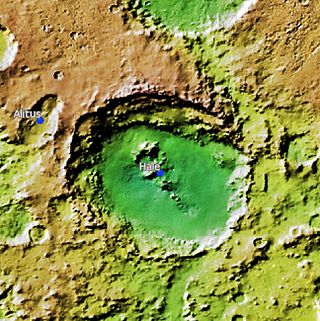
Hale is a 150 km × 125 km crater at 35.7°S, 323.4°E on Mars, just north of Argyre basin. The crater is in the Argyre quadrangle. It was named after American astronomer George Ellery Hale.

Crater Isabella is the second largest impact crater on Venus. The feature is named in honor of the 15th Century queen of Spain, Isabella I of Castile. Located at 30 degrees south latitude, 204 degrees east longitude, the crater has two extensive flow-like structures extending to the south and to the southeast. The end of the southern flow partially surrounds a pre-existing 40-kilometer (25 mi) circular volcanic shield. The southeastern flow shows a complex pattern of channels and flow lobes, and is overlain at its southeastern tip by deposits from a later 20-kilometer (12 mi) diameter impact crater, Cohn. The extensive flows, unique to Venusian impact craters, are a continuing subject of study for a number of planetary scientists. It is thought that the flows may consist of 'impact melt,' rock melted by the intense heat released in the impact explosion. An alternate hypothesis invokes 'debris flows,' which may consist of clouds of hot gases and both melted and solid rock fragments that race across the landscape during the impact event. That type of emplacement process is similar to that which occurs in violent eruptions on Earth, such as the 1991 Mount Pinatubo eruption in the Philippines.

Verdi is an impact crater on the planet Mercury. It was named after Italian Romantic composer Giuseppe Verdi (1813–1901) in 1979, as recognized by the International Astronomical Union. The crater's extensive ejecta blanket and secondary crater field are superposed on plains materials and older craters.

The Syrtis Major quadrangle is one of a series of 30 quadrangle maps of Mars used by the United States Geological Survey (USGS) Astrogeology Research Program. The Syrtis Major quadrangle is also referred to as MC-13.
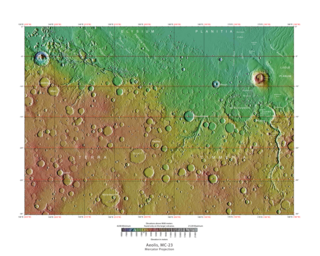
The Aeolis quadrangle is one of a series of 30 quadrangle maps of Mars used by the United States Geological Survey (USGS) Astrogeology Research Program. The Aeolis quadrangle is also referred to as MC-23 . The Aeolis quadrangle covers 180° to 225° W and 0° to 30° south on Mars, and contains parts of the regions Elysium Planitia and Terra Cimmeria. A small part of the Medusae Fossae Formation lies in this quadrangle.

Asimov Crater is an impact crater in the Noachis quadrangle of Mars, located at 47.0° S and 355.05° W. It is 84.0 km (52.2 mi) in diameter and was named after Isaac Asimov (1920–1992), an American biochemist and writer. The name was officially adopted on May 4, 2009.
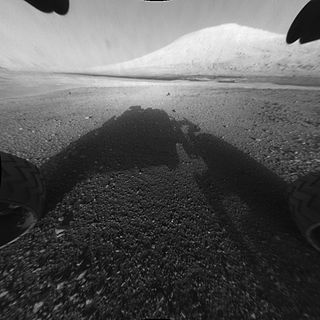
Mount Sharp, officially Aeolis Mons, is a mountain on Mars. It forms the central peak within Gale crater and is located around 5.08°S 137.85°E, rising 5.5 km (18,000 ft) high from the valley floor. Its ID in the United States Geological Survey's Gazetteer of Planetary Nomenclature is 15000.

Hottah is a rock outcrop on the surface of Aeolis Palus, between Peace Vallis and Aeolis Mons, in Gale crater on the planet Mars.
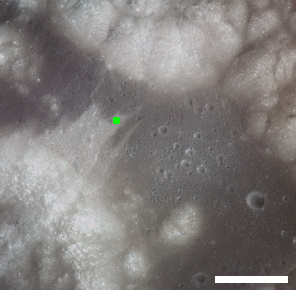
Shorty is a feature on Earth's Moon, an impact crater in the Taurus–Littrow valley. Astronauts Eugene Cernan and Harrison Schmitt visited it in 1972, on the Apollo 17 mission. It is the location of the famous "orange soil", which geologists believe to be small bits of rapidly-cooled molten rock ejected in a fire fountain. It is about 110 meters in diameter and up to 14 m (15 yd) deep.
Shorty Crater is about 14 m deep. Based on our investigations at the site and later examination of photographs, the impact that formed it penetrated, in order, regolith on the avalanche deposit, the avalanche deposit, regolith on a basalt flow, a basalt flow overlying and protecting the orange and black glass layers, the orange and black glass layers, regolith on a second basalt flow, and, finally, the upper portion of that second flow. Orange and black glass clods and basalt boulders are spread throughout the ejecta blanket surrounding Shorty.
Ghost craters on the planet Mercury have tectonic features such as graben and wrinkle ridges. These features were formed by extensional and contractional forces originating in tectonic processes such as uplift and global contraction. The combination of graben and wrinkle ridges inside ghost craters found on Mercury has not been observed on any of the other terrestrial planets.

Copernicus is a large crater on Mars, with a diameter close to 300 km. It is located south of the planet's equator in the heavily cratered highlands of Terra Sirenum in the Phaethontis quadrangle at 48.8°S and 191.2°E. Its name was approved in 1973, and it was named after Nicolaus Copernicus.

Very is a crater on Mars, located south of the planet's equator in the heavily cratered highlands of Terra Sirenum in the Phaethontis quadrangle at 49.2°S and 177.1°W. It measures approximately 114.81 kilometres (71.34 mi) in diameter. The crater was named after American astronomer Frank Washington Very.

Garni is an impact crater on Mars, in which, according to NASA, there is evidence of liquid water. In the press release of its finding on 28 September 2015, NASA considered it "the latest of many breakthroughs" in their Mars exploration. NASA and the US Geological Survey named the crater after the Armenian village of Garni. The naming was approved and adopted by the International Astronomical Union (IAU) on April 24, 2015.

Menrva is the largest crater on Titan, with a diameter of 392 kilometers. The crater is a heavily eroded double ringed impact basin, similar to the impact related features of Mars and Mercury. This is evident by Menrva's distinct lack of a central peak, indicating modification of the crater's surface since formation. It has been estimated that Menrva is approximately 2.8 kilometers deep.





















